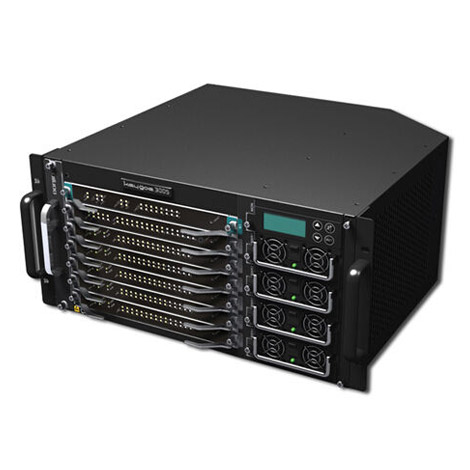Keygoe3005 Multimedia Switch
DONJIN Keygoe3005 multimedia switch is large-capacity, flexible-expansion, excellent-performance, high-reliability, and programmable multimedia processing platform for carrier-grade applications. A standalone Keygoe3005 supports 64 E1 trunk access, and one switch can support 180 analog phone access, and provide a maximum of 1920 voice resources, 1920 VoIP resources, 480 fax resources, 1024 conference resources, 180 recording resources for digital phones, 128 SS7 links (64 kbps), 16 SS7 links (2 Mbps), and 32 SS7 links (2 Mbps in high-impedance monitoring mode), which has the carrier operation grade reliability.
l Modularization system design, supporting the smooth linear expansion;
l Support a maximum of 16 device stacking, for 30,000 line non-blocking exchange;
l System monitoring and alarms for chassis temperature, fan rotating speed, and power states;
l High reliability: port redundancy, board redundancy, power redundancy, power input redundancy, and hot standby;
l Cooling design:
The signal processing module and power module have respective cooling passages;
Silence fan with large exhaust, forced air cooling;
Fan near the heat radiation circuits, bringing the most heat off effectively;
Minimum air resistance design in chassis;
Each power module has two respective fans;
Anti-Dust filter mesh to avoid dusts.

l EMC
 The air ventilator adopts regular hexagon cellular design which circumcircle diameter is 5 mm, which also screens the electromagnetism effectively under the premise of cooling the device;
The air ventilator adopts regular hexagon cellular design which circumcircle diameter is 5 mm, which also screens the electromagnetism effectively under the premise of cooling the device;
 The chassis adopts metal plates, and the contacted surfaces are not sprayed to ensure the electromagnetic shielding effect;
The chassis adopts metal plates, and the contacted surfaces are not sprayed to ensure the electromagnetic shielding effect;
 The elastic conductive fabric is installed in the cable outlet to make up the cable gaps, which can prevent the tiny electromagnetic penetrating;
The elastic conductive fabric is installed in the cable outlet to make up the cable gaps, which can prevent the tiny electromagnetic penetrating;
 In the gap, the screening reed in beryllium bronze is installed, not only ensuring the elasticity, but also possessing shielding effect;
In the gap, the screening reed in beryllium bronze is installed, not only ensuring the elasticity, but also possessing shielding effect;
 The power input/output adds the filter circuit.
The power input/output adds the filter circuit.
l Maintenance
 The rear side uses the bevel, convenient for handling wires;
The rear side uses the bevel, convenient for handling wires;
 Only by hand, you could operate on the device, which shortens the maintenance time.
Only by hand, you could operate on the device, which shortens the maintenance time.
7 slots
l 6 service slots
A maximum of 4 common signaling processing boards can be inserted (16 E1s for each board);
A maximum of 6 analog interface boards can be inserted (30 channels for each board)
A maximum of 6 digital phone recording boards can be inserted (30 channels for each board);
A maximum of 1 fiber channel exchange matrix board can be inserted.
l 1 exchange control slot
A maximum of 1 network exchange board can be inserted;
A maximum of 1 fiber channel exchange matrix board can be inserted.
4 power module slots
A maximum of 4 device system power modules can be inserted;
A maximum of 3 ring power modules can be inserted.
Capacity
l A maximum of 64 E1 digital trunk interfaces can be configured;
l A maximum of 180 analog agents can be configured;
l By optic exchange matrix, 32768-line non-blocking exchange system can be constructed;
l A standalone Keygoe3005 can provide a maximum of 1920 voice resources;
l A maximum of 128 SS7 links (64 kbps) can be provided;
l A maximum of 16 SS7 links (2Mbps) can be provided;
l A maximum of 32 SS7 links (2Mbps in high-impedance monitoring mode) can be provided;
l A standalone Keygoe3005 can provide a maximum of 1920 VoIP resources;
l A standalone Keygoe3005 can provide a maximum of 1024 conferences with 1920 members in conference simultaneously;
l A maximum of 480 fax resources can be provided;
l A maximum of 180 recording resources for digital phones can be provided;
l A maximum of 240 3G video resources can be provided.
Stacking count
l 16
Size
l Height: 219.4 mm (5U); width: 482.6 mm (19″); depth: 430 mm.
Power
l AC: 220VAC (range: 176–264 VAC ); frequency: 50 Hz;
l DC: -48V (range: -36V–-72V ).
Extensibility
l The port number can be increased linearly;
l Support the device stacking;
l Support the functional board hot swapping, and online extension.
System monitoring alarm
l Chassis temperature;
l Fan rotating speed;
l Power state.
Cooling system design
l High-Efficient cooling passage design;
l 6 cooling fans in low noise with large exhaust.
System redundancy
l 4 main power hot standby;
l Dual-Power inputs redundancy;
l Network exchange board interface redundancy;
l Hot standby for control server.
TDM interface and protocol
A) TDM interface
l Support the mixed configuration of digital interfaces and analog interfaces;
l Support the high-impedance recording and digital recording;
l Conform to the G.703, and support the coaxial cable (75 Ω unbalanced), twisted-pair cable (120 Ω balanced);
l Conform to the frame structure of G.704 and multiframe alignment of G.706;
l The 2048 kbps PCM confirms to the G.732 and G.796;
l The alarm conforms to the G.775;
l Support power fault alarming;
l The jitter buffer conforms to the G.823;
l The analog interface supports the analog trunk, analog user, analog high impedance, analog 2-line voice, analog 4-line voice, EM control, magneto telephone, 2B+D high-impedance, and so on.
B) Optical interface
l Each optical interface rate: 155.52 Mbit/s;
l Type: S1.1/L1.1/L1.2, confirming to the ITU-T G.957;
l Connector type: LC;
l Security: ITU-T G.664;
l Jitter buffer: The input/output jitter buffer confirms to the ITU-T G.825 and G.813.
C) SS7
l Conform to the ITU-T signaling system No.7, including the Q.700-Q.716, Q.721-Q.766, and Q.771-Q.795;
l Maximum message processing ability for each link: 500 MSU/s;
l Each link busy-hour call attempts (BHCA): 360 k;
l Support the MTP, TUP, ISUP, SCCP, and M3UA signaling function;
l Support the 64 kbps standard link and 2 Mbps high-speed link (monitoring);
l Support the 14/24-bit point codes;
l Support the traffic balancing between the links and link groups;
l Support the link switch and switch back in a link group;
l Support multiple OPCs (originating point codes) and DPCs(destination point codes);
l Support to dynamically add, delete, activate, recover, deactivate, normally restart, urgently restart signaling and to process signaling congestion.
D) ISDN PRI
l Conform to ITU-T Q.921 LAPD;
l Conform to ITU-T Q.931 ISDN PRI; European ISDN ETSI NET5;
l Support the network side and client side;
l Support the overlapping mode when receiving and sending called numbers.
IP interface and protocol
A) Network exchange interface
l TCP/IP 1000BASE-T port (RJ45).
SNMP
l Conform to the SNMPV1 and SNMPV2.
B) RTP
l Conform to the RTP/RTCP (RFC3551/3552);
l Voice packet sampling length/frame number can be configured (10–60 ms);
l Dynamic DTMF load of the RTP (RFC2833/4733);
l Jitter buffer: Support the static jitter mode and dynamic self-adaptation mode simultaneously;
l Analyze the network environment and make the statistics of packet loss;
l Support the NAT/firewall detection and transparency.
C) H.323
l Abide by the ITU-T H.323v2 (H.225v2/H.245v3);
l Support the coding standards of G.723, G.726, and G.729;
l Support the call parameters such as the fast start and H.245 tunneling;
l Call forwarding;
l Gatekeeper auto discovery and login (Support the number registration types of H.323 UID and E164);
l H.245 user input character and DTMF signal message (User Input Indication);
l Terminal registration management.
D) SIP
l Conform to the IETF SIPv2 (RFC3261);
l UDP/TCP transmission mode;
l MD5 (digest) identity test;
l REFER call forwarding (RFC3515);
l SIP message subscription/notice (RFC3265 SUBSCRIBE/NOTIFY);
l Proxy server register, user identification, and timely refreshing;
l SIP INFO message (RFC2976);
l Registrar; support the authentication of the service part;
l Support the STUN for NAT/firewall detection and transparency.
E) Audio/Video protocols
l Audio encoding/decoding format: G.711 μlaw/A law, G.723.1, (5.3/6.3 kbps self-adaptation), and G.729A/B/AB;
l Video encoding/decoding format: H.263/H.264/MPEG4;
l Media file format: 3GP/AVI;
l Voice activity detection/Silence compression (G.723/G.729);
l Comfort noise;
l Support the video conference.
Media resource
A) Voice resource
l Voice code format: Support the A law/μ law PCM, AMI-ADPCM, G729, G723.1, and so on;
l Voice file format: Support the WAVE, PCM, ADPCM, VOX, MP3, and so on;
l Support the transfer between the A law and μ law;
l Support the voice playing of the memory and file server in the real time;
l Support the recording of the file server in the real time (dynamic memory);
l Support the DTMF, FSK, R2, and tone detection of self-defined envelope;
l Support the DTMF, FSK, R2, and tone generation of self-defined envelope;
l Support the mixed voice recording and playing;
l Support the echo canceling (128 ms);
l Support the AGC/ALS;
l Support the voice recording and playing in a full duplex mode;
l Support the VAD and CNG;
l Support the DPD and PVD.
B) Fax resource
l Support the V17/V29/V27 with the rates of 14400/9600/7200/4800/2400bps; support the automatic down speeding;
l Support the T.30 and T.38;
l Support to receive/send fax in an ECM mode, selecting ECM/NON-ECM mode automatically;
l Support to input the .tiff file using the MR, MH, and MMR; support to send/receive files using the MH.
C) 3G-324M video resource
l Video encoding: H.263/MPEG4;
l Audio encoding: AMR, G.723.1;
l Signaling control protocol: H.245;
l Multiplexing protocol: H.223;
l Media file format: 3GP/AVI.
D) Host video transcoding resource
l Video encoding/decoding: H.263/H.264/MPEG4;
l Support the video conference.
Application development:
l Operating systems: Windows2000/XP/2003/Vista;
Windows 7 Ultimate (32/64 bits );
Windows Server R2 (32/64 bits );
Linux (2.6 or later);
l Development language: ANSI C/C++, Microsoft Visual C++, C#, Delphi;
l Development platform: Keygoe SDK V2.2.0 or later.
Environment parameters
l Temperature: 0°C–40°C;
l Relative humidity: 10%–85%;
l Air cleanliness: For the dust particle which diameter is more than 0.5 μm, the density cannot be over 3500 particles per litre. For the dust particle which diameter is more than 5 μm, the density cannot be over 30 particles per litre. Avoid excessive dusts, velvet, carbon granules, paper fiber things, and metal things;
l Electromagnetic environment: Electric field strength≤130 dB (μV/m ), magnetic field strength≤800 A/m;
l Anti-Static: The device is grounded reliably.
Grounding requirement
l The grounding resistance cannot be over 1.5 Ω.
Installation:
l Installed in a standard 19" rack;
l The rack need be fixed to the floor;
l The front board or middle part of the rack need be fixed.
l Voice services: IVR, telephone conferencing, color ring back tone (CRBT), background music, and telephone recording;
l Video services: multimedia CRBT, video telephone, video conference, video mail, 3G video, and video monitoring;
l Signaling services: virtual telephone exchange, signaling gateway, missed call service for fixed lines, integrated access gateway, media gateway, and mobile positioning;
l Integrated services: VoIP, unified messaging, Internet faxing, integrated QQ, and mobile payment;
l Call control services: pre-payment, post-payment, intelligent public telephone, and callback;
l Next-generation network: multimedia resource server;
l Call center: automatic voice playing, conference recording, IP agent, remote agent, video application, Web800, calling out, and automatic callback.

 “Financial Product”WeChat
“Financial Product”WeChat “Telecommunication Product”WeChat
“Telecommunication Product”WeChat









 Download
Download